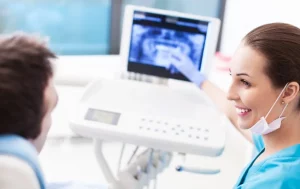
MRI, or “Magnetic Resonance Imaging,” is a noninvasive imaging technique that produces images of the insides of objects or the human body. It is a radiological approach that employs radio waves as well as magnets. The computer’s output is inspected and recorded by its operator. The patient is placed on a moveable bed and inserted into a tube enclosed by a massive spherical magnet.
The entire process takes only a few minutes; the magnet within the gadget sets off a chain reaction that aligns protons and hydrogen atoms for exposure to radio wave beams. The protons in the body then react, producing a weak signal detected by the machine’s receiver and directed to the output device. The incoming input is processed further by the computer before being provided to the operator as readable output. An image is created that, with closer examination, will reveal whether anything alien or unnatural is present within the body. Small changes in body structure are identified and appropriately responded to. In some circumstances, gadolinium or other contrast ants are employed to improve machine precision.
As previously stated, mri brain scan in New Jersey scanners are commonly employed in the medical industry. Medical imaging can detect pathological or physiological changes in the body. However, it is not wholly limited to the medical field because the gadget might also be utilized for geological objectives. It can also be used to identify rock permeability, which is a non-destructive way for testing the quality of materials such as wood.
It is now the most advanced disease detection system that humans have built, capable of detecting bodily abnormalities and anomalies within our heads, specifically the brain. Exceptions that may lead to aneurysms, strokes, and difficult-to-detect brain malignancies can be discovered and, if possible, prevented. Neurosurgeons utilize this gadget to extensively examine the body following significant accidents to assess the spinal column’s integrity. Any heart abnormalities and any other irregularities within the body that cannot be seen using conventional means can be discovered.
Overall, MRI ensures that the doctor knows exactly which portion of the body requires surgery. To arrive at a decisive result, an accurate presentation of the body and any defects on the inside is made and inspected. It is a relatively painless scan of the body, and while it is expensive for one-time use, it provides the patient with peace of mind or knowledge of his body’s current state. Scientists are working on new and improved MRI equipment that will allow for more in-depth medical exams of the body.



